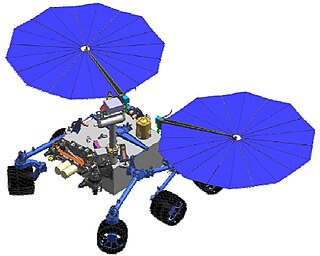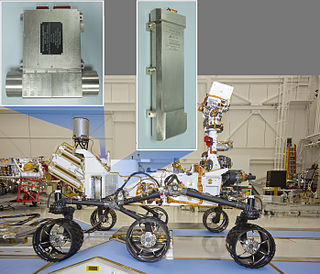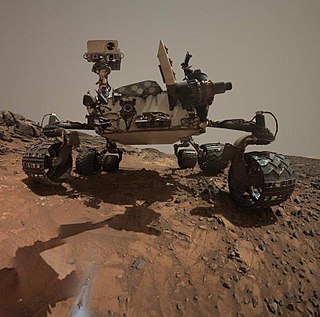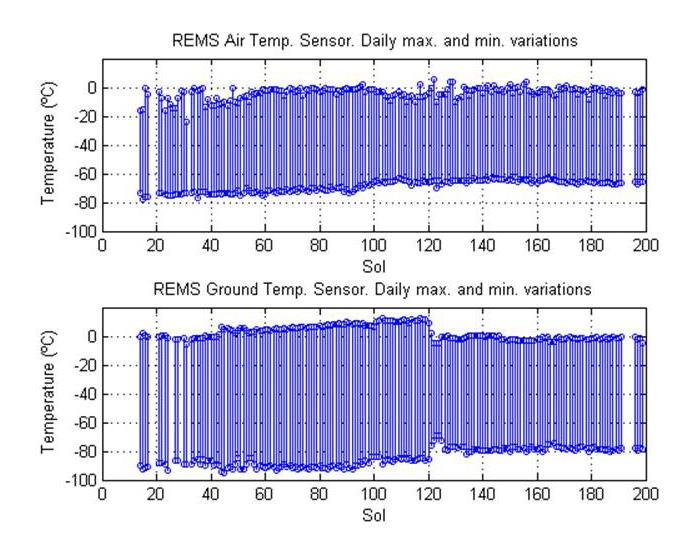
2001 Mars Odyssey is a robotic spacecraft orbiting the planet Mars. The project was developed by NASA, and contracted out to Lockheed Martin, with an expected cost for the entire mission of US$297 million. Its mission is to use spectrometers and a thermal imager to detect evidence of past or present water and ice, as well as study the planet's geology and radiation environment. It is hoped that the data Odyssey obtains will help answer the question of whether life existed on Mars and create a risk-assessment of the radiation that future astronauts on Mars might experience. It also acts as a relay for communications between the Curiosity rover, and previously the Mars Exploration Rovers and Phoenix lander, to Earth. The mission was named as a tribute to Arthur C. Clarke, evoking the name of his and Stanley Kubrick's 1968 film 2001: A Space Odyssey.

A Mars rover is a motor vehicle that travels across the surface of the planet Mars upon arrival. Rovers have several advantages over stationary landers: they examine more territory, they can be directed to interesting features, they can place themselves in sunny positions to weather winter months, and they can advance the knowledge of how to perform very remote robotic vehicle control.

Mars Science Laboratory (MSL) is a robotic space probe mission to Mars launched by NASA on November 26, 2011, which successfully landed Curiosity, a Mars rover, in Gale Crater on August 6, 2012. The overall objectives include investigating Mars' habitability, studying its climate and geology, and collecting data for a human mission to Mars. The rover carries a variety of scientific instruments designed by an international team.
A life-support system is the combination of equipment that allows survival in an environment or situation that would not support that life in its absence. It is generally applied to systems supporting human life in situations where the outside environment is hostile, such as in space or underwater, or medical situations where the health of the person is compromised to the extent that the risk of death would be high without the function of the equipment.

The climate of Mars has been a topic of scientific curiosity for centuries, in part because it is the only terrestrial planet whose surface can be directly observed in detail from the Earth with help from a telescope.
The embedded computer systems on board the Mars rovers sent by NASA must withstand the high radiation levels and large temperature changes in space. For this reason their computational resources are limited compared to systems commonly used on Earth.

The Mars Astrobiology Explorer-Cacher (MAX-C), also known as Mars 2018 mission was a NASA concept for a Mars rover mission, proposed to be launched in 2018 together with the European ExoMars rover. The MAX-C rover concept was cancelled in April 2011 due to budget cuts.

Sample Analysis at Mars (SAM) is a suite of instruments on the Mars Science Laboratory Curiosity rover. The SAM instrument suite will analyze organics and gases from both atmospheric and solid samples. It was developed by the NASA Goddard Space Flight Center, the Laboratoire des Atmosphères Milieux Observations Spatiales (LATMOS) associated to the Laboratoire Inter-Universitaire des Systèmes Atmosphériques (LISA), and Honeybee Robotics, along with many additional external partners.

Curiosity is a car-sized Mars rover designed to explore the Gale crater on Mars as part of NASA's Mars Science Laboratory (MSL) mission. Curiosity was launched from Cape Canaveral (CCAFS) on 26 November 2011, at 15:02:00 UTC and landed on Aeolis Palus inside Gale crater on Mars on 6 August 2012, 05:17:57 UTC. The Bradbury Landing site was less than 2.4 km (1.5 mi) from the center of the rover's touchdown target after a 560 million km (350 million mi) journey.

The Dynamic Albedo of Neutrons (DAN) instrument is an experiment mounted on the Mars Science Laboratory'sCuriosity rover. It is a pulsed sealed-tube neutron source and detector used to measure hydrogen or ice and water at or near the Martian surface. The instrument consists of the detector element (DE) and a 14.1 MeV pulsing neutron generator (PNG). The die-away time of neutrons is measured by the DE after each neutron pulse from the PNG. DAN was provided by the Russian Federal Space Agency, funded by Russia and is under the leadership of Principal Investigator Igor Mitrofanov.

The Mars Science Laboratory and its rover, Curiosity, were launched from Earth on November 26, 2011. As of June 30, 2021, Curiosity has been on the planet Mars for 3163 sols since landing on August 5, 2012. (See Current status.)

Bradbury Landing is the 6 August 2012, landing site within Gale crater on planet Mars of the Mars Science Laboratory (MSL) Curiosity rover. On 22 August 2012 on what would have been his 92nd birthday, NASA named the site for author Ray Bradbury, who had died on 5 June 2012. The coordinates of the landing site on Mars are: 4.5895°S 137.4417°E.
Exposing Microorganisms in the Stratosphere (E-MIST) is a NASA study to determine if a specific microorganism could survive conditions like those on the planet Mars. The study transported Bacillus pumilus bacteria and their spores by helium-filled balloon to the stratosphere of Earth and monitored the ability of the microorganisms to survive in extreme Martian-like conditions such as low pressure, dryness, cold, and ionizing radiation.
HABIT is an instrument designed to harvest water from the Mars atmosphere, an experiment that might pave the way to future water farms on Mars. The instrument will be placed on board the Kazachok lander, to be launched in 2022.

The Mars Environmental Dynamics Analyzer (MEDA) is an instrument on board the Mars 2020 Perseverance rover that will characterize the dust size and morphology, as well as surface weather. Specifically, the information obtained will help address future human exploration objectives, as dust sizes and shapes, daily weather report and information on the radiation and wind patterns on Mars, that are critical for proper design of in situ resource utilization systems. MEDA is a follow-on project from REMS, of the Curiosity rover mission. MEDA has an increased scope, with greater data collection on Mars dust which contributes to overall Mars program objectives and discovery goals.

A Mars suit or Mars space suit is a space suit for EVAs on the planet Mars. Compared to a suit designed for space-walking in the near vacuum of low Earth orbit, Mars suits have a greater focus on actual walking and a need for abrasion resistance. Mars' surface gravity is 37.8% of Earth's, approximately 2.3 times that of the Moon, so weight is a significant concern, but there are fewer thermal demands compared to open space. At the surface the suits would contend with the atmosphere of Mars, which has a pressure of about 0.6 to 1 kilopascal. On the surface, radiation exposure is a concern, especially solar flare events, which can dramatically increase the amount of radiation over a short time.
ADRON-RM is a neutron spectrometer to search for subsurface water ice and hydrated minerals. This analyser is part of the science payload on board the European Space Agency'sRosalind Franklin rover, tasked to search for biosignatures and biomarkers on Mars. The rover is planned to be launched in August–October 2022 and land on Mars in spring 2023.
Javier Martín-Torres is a Spanish physicist with interests in atmospheric sciences, geophysics, and astrobiology. He has published over 150 scientific papers in these areas, and contributed to more than 500 presentations at international conferences.

Temperature and Winds for InSight (TWINS) is a meteorological suite of instruments on board the InSight lander that landed on Mars on 26 November 2018. TWINS will provide continuous wind and air temperature measurements to help understand the seismic data from the SEIS instrument. The instruments were developed by the Spanish Astrobiology Center at Madrid, Spain.
Spanish Astrobiology Center is a state-run institute in Spain dedicated to astrobiology research, and it is part of the National Institute of Aerospace Technology (INTA) as well as the Spanish National Research Council (CSIC). It was created in 1999 and it is affiliated with NASA Astrobiology Institute.


















